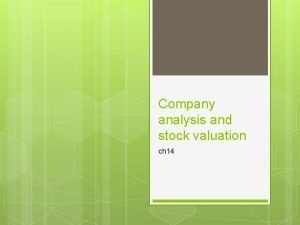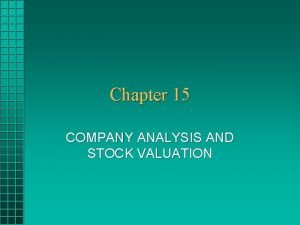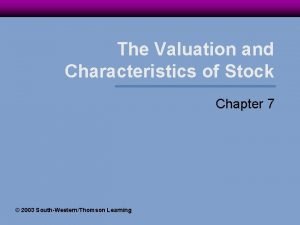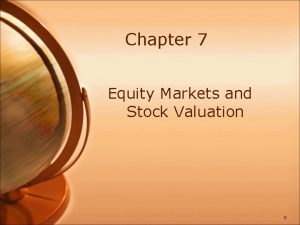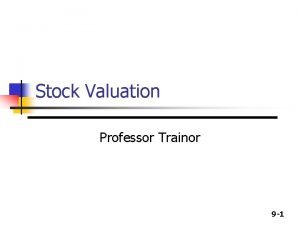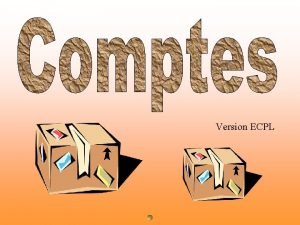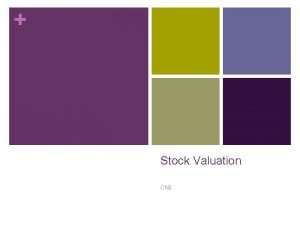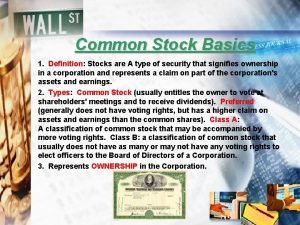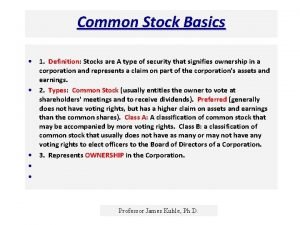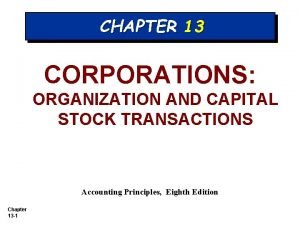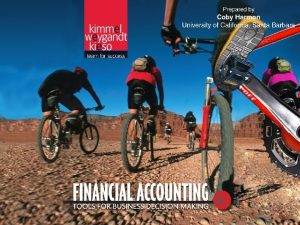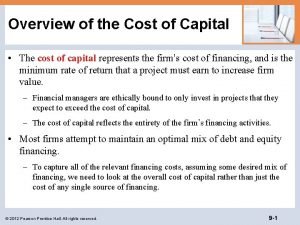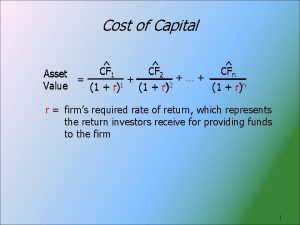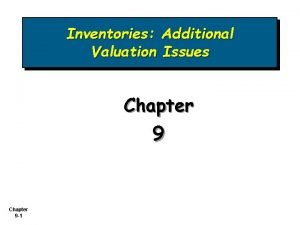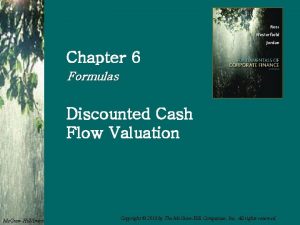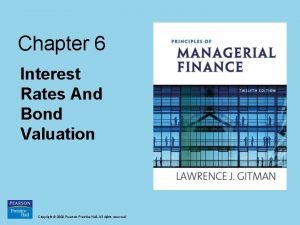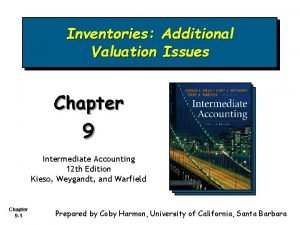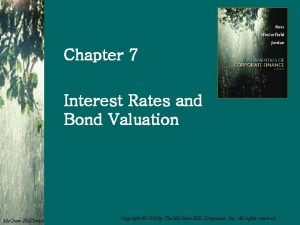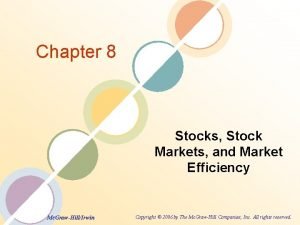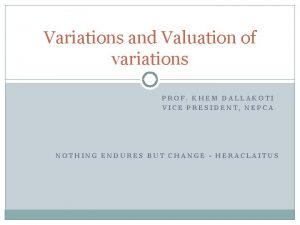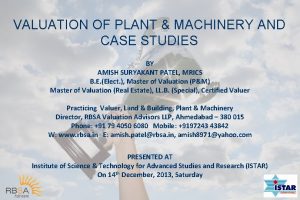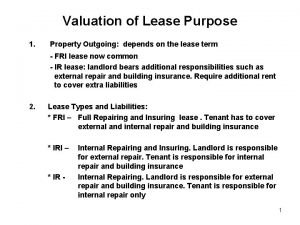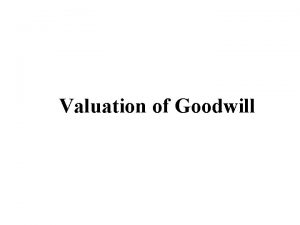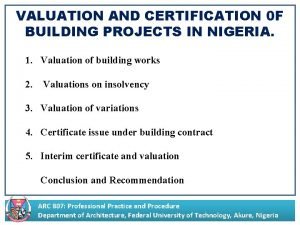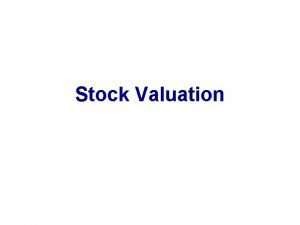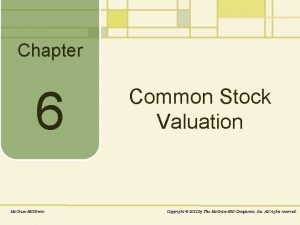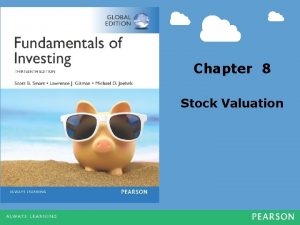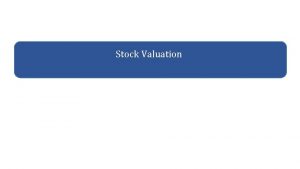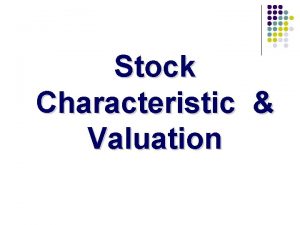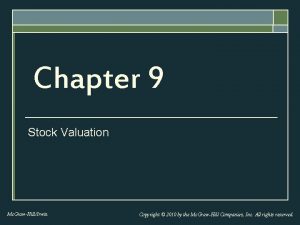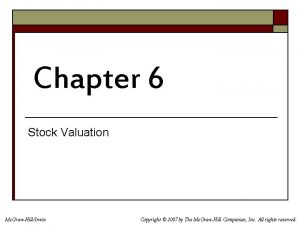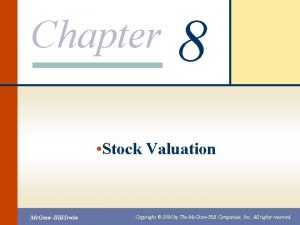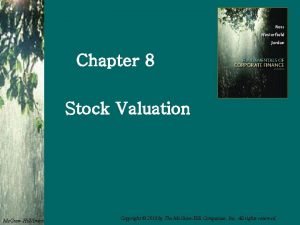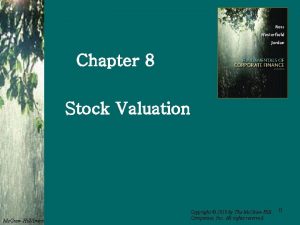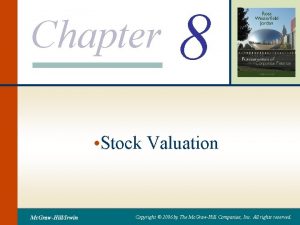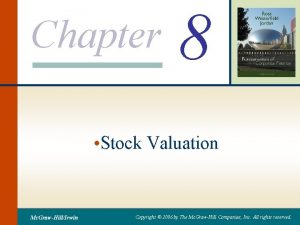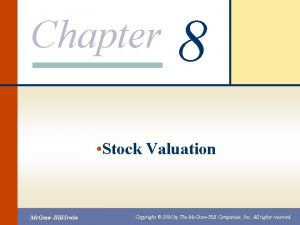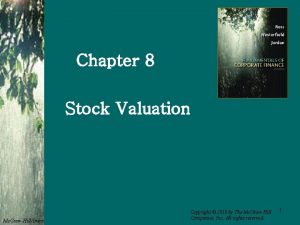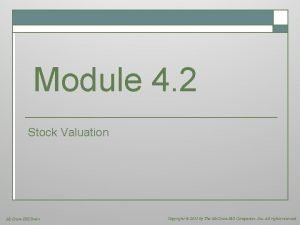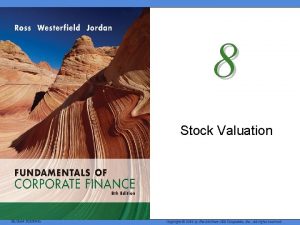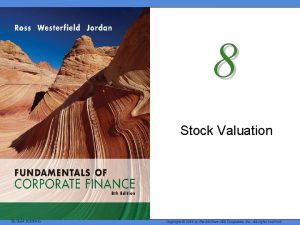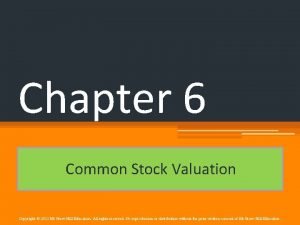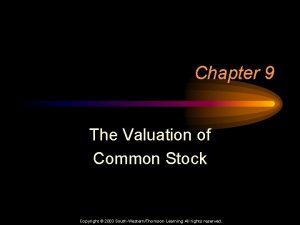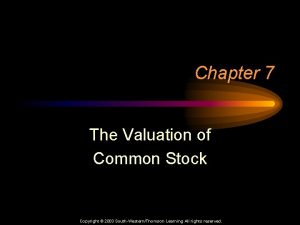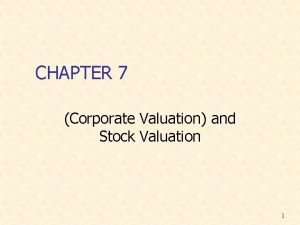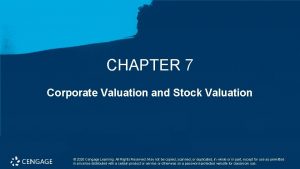Chapter 6 Mc GrawHillIrwin Common Stock Valuation Copyright










































- Slides: 42

Chapter 6 Mc. Graw-Hill/Irwin Common Stock Valuation Copyright © 2012 by The Mc. Graw-Hill Companies, Inc. All rights reserved.

Security Analysis: Be Careful Out There • Fundamental analysis is a term for studying a company’s accounting statements and other financial and economic information to estimate the economic value of a company’s stock. • The basic idea is to identify “undervalued” stocks to buy and “overvalued” stocks to sell. • In practice however, such stocks may in fact be correctly priced for reasons not immediately apparent to the analyst. 6 -2

The Dividend Discount Model • The Dividend Discount Model (DDM) is a method to estimate the value of a share of stock by discounting all expected future dividend payments. The basic DDM equation is: • In the DDM equation: – P 0 = the present value of all future dividends – Dt = the dividend to be paid t years from now – k = the appropriate risk-adjusted discount rate 6 -3

Example: The Dividend Discount Model • Suppose that a stock will pay three annual dividends of $200 per year, and the appropriate risk-adjusted discount rate, k, is 8%. • In this case, what is the value of the stock today? 6 -4

Example: The Constant Growth Rate Model • Suppose the current dividend is $10, the dividend growth rate is 10%, there will be 20 yearly dividends, and the appropriate discount rate is 8%. • What is the value of the stock, based on the constant growth rate model? 6 -5

The Dividend Discount Model: the Constant Perpetual Growth Model • Assuming that the dividends will grow forever at a constant growth rate g. • For constant perpetual dividend growth, the DDM formula becomes: 6 -6

Example: Constant Perpetual Growth Model • Think about the electric utility industry. • In 2009, the dividend paid by the utility company, DTE Energy Co. (DTE), was $2. 12. • Using D 0 =$2. 12, k = 5. 75%, and g = 2%, calculate an estimated value for DTE. Note: the actual mid-2009 stock price of DTE was $40. 29. What are the possible explanations for the difference? 6 -7

The Dividend Discount Model: Estimating the Growth Rate • The growth rate in dividends (g) can be estimated in a number of ways: – Using the company’s historical average growth rate. – Using an industry median or average growth rate. – Using the sustainable growth rate. 6 -8

The Historical Average Growth Rate • Suppose the Broadway Joe Company paid the following dividends: – 2005: $1. 50 – 2006: $1. 70 – 2007: $1. 75 • 2008: $1. 80 2009: $2. 00 2010: $2. 20 The spreadsheet below shows how to estimate historical average growth rates, using arithmetic and geometric averages. 6 -9

The Sustainable Growth Rate • Return on Equity (ROE) = Net Income / Equity • Payout Ratio = Proportion of earnings paid out as dividends • Retention Ratio = Proportion of earnings retained for investment 6 -10

Example: Calculating and Using the Sustainable Growth Rate • In 2009, American Electric Power (AEP) had an ROE of 10%, projected earnings per share of $2. 90, and a pershare dividend of $1. 64. What was AEP’s: – Retention rate? – Sustainable growth rate? • Payout ratio = $1. 64 / $2. 90 =. 566 or 56. 6% • So, retention ratio = 1 –. 566 =. 434 or 43. 4% • Therefore, AEP’s sustainable growth rate =. 10 . 434 =. 0434, or 4. 34% 6 -11

Example: Calculating and Using the Sustainable Growth Rate, Cont. • What is the value of AEP stock using the perpetual growth model and a discount rate of 5. 75%? • The actual late-2009 stock price of AEP was $31. 83. • In this case, using the sustainable growth rate to value the stock gives a reasonably poor estimate. • What can we say about g and k in this example? 6 -12

Analyzing ROE • To estimate a sustainable growth rate, you need the (relatively stable) dividend payout ratio and ROE. • Changes in sustainable growth rate likely stem from changes in ROE. • The Du. Pont formula separates ROE into three parts (profit margin, asset turnover, equity multiplier) • Managers can increase the sustainable growth rate by: – – Decreasing the dividend payout ratio Increasing profitability (Net Income / Sales) Increasing asset efficiency (Sales / Assets) Increasing debt (Assets / Equity) 6 -13

The Two-Stage Dividend Growth Model • The two-stage dividend growth model assumes that a firm will initially grow at a rate g 1 for T years, and thereafter, it will grow at a rate g 2 < k during a perpetual second stage of growth. • The Two-Stage Dividend Growth Model formula is: 6 -14

Using the Two-Stage Dividend Growth Model, I. • Although the formula looks complicated, think of it as two parts: – Part 1 is the present value of the first T dividends (it is the same formula we used for the constant growth model). – Part 2 is the present value of all subsequent dividends. • So, suppose Miss. Molly. com has a current dividend of D 0 = $5, which is expected to shrink at the rate, g 1 = 10%, for 5 years but grow at the rate, g 2 = 4%, forever. • With a discount rate of k = 10%, what is the present value of the stock? 6 -15

Using the Two-Stage Dividend Growth Model, II. • The total value of $46. 03 is the sum of a $14. 25 present value of the first five dividends, plus a $31. 78 present value of all subsequent dividends. 6 -16

Example: Using the DDM to Value a Firm Experiencing “Supernormal” Growth, I. • Chain Reaction, Inc. , has been growing at a phenomenal rate of 30% per year. • You believe that this rate will last for only three more years. • Then, you think the rate will drop to 10% per year. • Total dividends just paid were $5 million. • The required rate of return is 20%. • What is the total value of Chain Reaction, Inc. ? 6 -17

Example: Using the DDM to Value a Firm Experiencing “Supernormal” Growth, II. • First, calculate the total dividends over the “supernormal” growth period: Year Total Dividend: (in $millions) 1 $5. 00 x 1. 30 = $6. 50 2 $6. 50 x 1. 30 = $8. 45 3 $8. 45 x 1. 30 = $10. 985 • Using the long run growth rate, g, the value of all the shares at Time 3 can be calculated as: P 3 = [D 3 x (1 + g)] / (k – g) P 3 = [$10. 985 x 1. 10] / (0. 20 – 0. 10) = $120. 835 6 -18

Example: Using the DDM to Value a Firm Experiencing “Supernormal” Growth, III. • To determine the present value of the firm today, we need the present value of $120. 835 and the present value of the dividends paid in the first 3 years: If there are 20 million shares outstanding, the price per share is $4. 38. 6 -19

The H-Model, I. • For Chain Reaction, Inc. , we assumed a supernormal growth rate of 30 percent per year for three years, and then growth at a perpetual 10 percent. • The growth rate is more likely to start at a high level and then fall over time until reaching its perpetual level. • Many possible ways to assume how the growth rate declines • A popular way is the H-model: which assumes a linear growth rate decline 6 -20

The H-Model, II. • Let’s revisit Chain Reaction, Inc. – Suppose the growth rate begins at 30% and reaches 10% in year 4 and beyond. – Using the H-model, we would assume that the company’s growth rate would decline by 20% from the end of year 1 to the beginning of year 4. • If we assume a linear decline: – the growth rate falls by 6. 67% per year (20%/3 years). – Growth estimates would be: 30%, 23. 33%, 16. 66%, and 10% • Using these growth estimates, you will find that the firm value is $75. 93 million, or $3. 80 per share. • The value is lower than before because of the lower growth rates in years 2 and 3. 6 -21

Discount Rates for Dividend Discount Models • The discount rate for a stock can be estimated using the capital asset pricing model (CAPM ). • We will discuss the CAPM in a later chapter. • However, we can estimate the discount rate for a stock using this formula: Discount rate = time value of money + risk premium = U. S. T-bill Rate + (Stock Beta x Stock Market Risk Premium) T-bill Rate: return on 90 -day U. S. T-bills Stock Beta: risk relative to an average stock Stock Market Risk risk premium for an average stock Premium: 6 -22

Observations on Dividend Discount Models, I. Constant Perpetual Growth Model: • • • Simple to compute Not usable for firms that do not pay dividends Not usable when g > k Is sensitive to the choice of g and k k and g may be difficult to estimate accurately. Constant perpetual growth is often an unrealistic assumption. 6 -23

Observations on Dividend Discount Models, II. Two-Stage Dividend Growth Model: • • • More realistic in that it accounts for two stages of growth Usable when g > k in the first stage Not usable for firms that do not pay dividends Is sensitive to the choice of g and k k and g may be difficult to estimate accurately. 6 -24

Residual Income Model (RIM), I. • We have valued only companies that pay dividends. – But, there are many companies that do not pay dividends. – What about them? – It turns out that there is an elegant way to value these companies, too. • The model is called the Residual Income Model (RIM). • Major Assumption (known as the Clean Surplus Relationship, or CSR): The change in book value per share is equal to earnings per share minus dividends. 6 -25

Residual Income Model (RIM), II. • Inputs needed: – – Earnings per share at time 0, EPS 0 Book value per share at time 0, B 0 Earnings growth rate, g Discount rate, k • There are two equivalent formulas for the Residual Income Model: BTW, it turns out that the RIM is mathematically the same as the constant perpetual growth model. 6 -26

Using the Residual Income Model • Duckwall—Alco Stores, Inc. (DUCK) • It is July 1, 2010—shares are selling in the market for $10. 94. • Using the RIM: – – – EPS 0 = $1. 20 DIV = 0 B 0 = $5. 886 g = 0. 09 k =. 13 • What can we say about the market price of DUCK? 6 -27

The Growth of DUCK • Using the information from the previous slide, what growth rate results in a DUCK price of $10. 94? 6 -28

Free Cash Flow, I. • We can value companies that do not pay dividends using the residual income model. • Note: We assume positive earnings when we use the residual income model. • But, there are companies that do not pay dividends and have negative earnings. • Negative earnings = little value? – We calculate earnings based on accounting rules and tax codes. – It is possible that a company has: • negative earnings • positive cash flows • a positive value. 6 -29

Free Cash Flow, II. • Depreciation—the key to understand how a company can have negative earnings and positive cash flows • Depreciation reduces earnings because it is counted as an expense (more expenses = lower taxes paid). • Most stock analysts, however, use a relatively simple formula to calculate Free Cash Flow, FCF: FCF = Net Income + Depreciation – Capital Spending • We can see that it is possible for: Net Income < 0 and FCF > 0 • Depreciation and Capital Spending matter in FCF. 6 -30

DDMs Versus FCF • The DDMs calculate a value of the equity only. – DDMs use dividends, a cash flow only to equity holders – DDMs use the CAPM to estimate required return – DDMs use an equity beta to account for risk • Using the FCF model, we calculate a value for the firm. – Free cash flow can be paid to debt holders and to stockholders. – We can still calculate the value of equity using FCF • Calculate the value of the entire firm • Subtract out the value of debt – We need a beta for assets, not the equity, to account for risk 6 -31

Asset Betas • Asset betas measure the risk of the company’s industry. – Firms in an industry should have about the same asset betas. – Their equity betas, however, could be quite different. • Investors can increase portfolio risk by using margin (i. e. , borrowing money to buy stock). • A business can increase risk by using debt. • So, to value the company, we must “convert” reported equity betas into asset betas by adjusting for leverage. • The following conversion formula is widely used: • What happens when a firm has no debt? tax rate. 6 -32

The FCF Approach, Example • Inputs – An estimate of FCF: • Net Income • Depreciation • Capital Expenditures – – – The growth rate of FCF The proper discount rate Tax rate Debt/Equity ratio Equity beta • Calculate value using a “DDM” formula • “DDM” because we are using FCF, not dividends. 6 -33

Valuing Landon Air: A New Airline • An estimate of FCF: – – – – Net Income: $25 million Depreciation: $10 million Capital Expenditures: $3 million Growth rate of FCF: 3% Tax rate: 35% Debt/Equity ratio: . 40 Equity beta: 1. 2 Assume: No dividends Risk-free rate = 4% Market risk premium = 7% • Asset Beta: 1. 2 = BAsset x [1+. 4 x (1 -. 35)] 1. 2 = BAsset x 1. 26 BAsset = 0. 95 • The proper discount rate: k = 4. 00 + (7. 00 × 0. 95) = 10. 65% 6 -34

Price Ratio Analysis, I. • Price-earnings ratio (P/E ratio) – Current stock price divided by annual earnings per share (EPS) • Earnings yield – Inverse of the P/E ratio: earnings divided by price (E/P) • High-P/E stocks are often referred to as growth stocks, while low-P/E stocks are often referred to as value stocks. 6 -35

Price Ratio Analysis, II. • Price-cash flow ratio (P/CF ratio) – Current stock price divided by current cash flow per share – In this context, cash flow is usually taken to be net income plus depreciation. • Most analysts agree that in examining a company’s financial performance, cash flow can be more informative than net income. • Earnings and cash flows that are far from each other may be a signal of poor quality earnings. 6 -36

Price Ratio Analysis, III. • Price-sales ratio (P/S ratio) – Current stock price divided by annual sales per share – A high P/S ratio suggests high sales growth, while a low P/S ratio suggests sluggish sales growth. • Price-book ratio (P/B ratio) – Market value of a company’s common stock divided by its book (accounting) value of equity – A ratio bigger than 1. 0 indicates that the firm is creating value for its stockholders. 6 -37

Price/Earnings Analysis, Intel Corp (INTC) - Earnings (P/E) Analysis 5 -year average P/E ratio Current EPS growth rate 20. 96 $. 92 8. 5% Expected stock price = historical P/E ratio projected EPS $20. 92 = 20. 96 ($. 92 1. 085) Late-2009 stock price = $19. 40 6 -38

Price/Cash Flow Analysis, Intel Corp (INTC) - Cash Flow (P/CF) Analysis 5 -year average P/CF ratio Current CFPS growth rate 10. 85 $1. 74 7. 5% Expected stock price = historical P/CF ratio projected CFPS $20. 29 = 10. 85 ($1. 74 1. 075) Late-2009 stock price = $19. 40 6 -39

Price/Sales Analysis, Intel Corp (INTC) - Sales (P/S) Analysis 5 -year average P/S ratio Current SPS growth rate 3. 14 $6. 76 7% Expected stock price = historical P/S ratio projected SPS $22. 71 = 3. 14 ($6. 76 1. 07) Late-2009 stock price = $19. 40 6 -40

The Mc. Graw-Hill Company Analysis, IV. 6 -41

Useful Internet Sites • • • www. nyssa. org (The New York Society of Security Analysts) www. aaii. com (The American Association of Individual Investors) www. valueline. com (the home of the Value Line Investment Survey) 6 -42
 Common stock valuation
Common stock valuation Features of preferred stock
Features of preferred stock Characteristics of corporate bonds and stocks
Characteristics of corporate bonds and stocks Valuation of bonds
Valuation of bonds Company analysis
Company analysis Avco stock valuation
Avco stock valuation Company analysis and stock valuation
Company analysis and stock valuation Characteristics of stock valuation
Characteristics of stock valuation Inventory grade 12 accounting
Inventory grade 12 accounting Equity markets and stock valuation
Equity markets and stock valuation Preferred stock valuation
Preferred stock valuation Brown stock adalah
Brown stock adalah Pramv
Pramv Common copyright
Common copyright Common stock definition
Common stock definition Common stock definition
Common stock definition John templeton's 16 rules for investment success
John templeton's 16 rules for investment success Issued common stock for cash journal entry
Issued common stock for cash journal entry Biaya modal manajemen keuangan
Biaya modal manajemen keuangan Statement of cash flow indirect method
Statement of cash flow indirect method Cost of debt
Cost of debt Cost of newly issued common stock
Cost of newly issued common stock Chapter 7 interest rates and bond valuation
Chapter 7 interest rates and bond valuation Chapter 9 inventories additional valuation issues
Chapter 9 inventories additional valuation issues Chapter 6 discounted cash flow valuation
Chapter 6 discounted cash flow valuation Chapter 5 bonds bond valuation and interest rates solutions
Chapter 5 bonds bond valuation and interest rates solutions Chapter 6 interest rates and bond valuation
Chapter 6 interest rates and bond valuation Lower of cost or market rule
Lower of cost or market rule Chapter 7 interest rates and bond valuation
Chapter 7 interest rates and bond valuation Chapter 6 interest rates and bond valuation
Chapter 6 interest rates and bond valuation Hcf of 48 and 60
Hcf of 48 and 60 Common anode and common cathode
Common anode and common cathode Gcf of 48 56 and 72
Gcf of 48 56 and 72 Factors of 54
Factors of 54 Common factors of 20 and 24
Common factors of 20 and 24 Highest common factors and lowest common multiples
Highest common factors and lowest common multiples Chapter 8 the stock market
Chapter 8 the stock market Valuation of variations
Valuation of variations Machinery valuation report
Machinery valuation report Outgoing in valuation
Outgoing in valuation Features of goodwill
Features of goodwill Valuation model of mnc
Valuation model of mnc Building valuation certificate
Building valuation certificate




